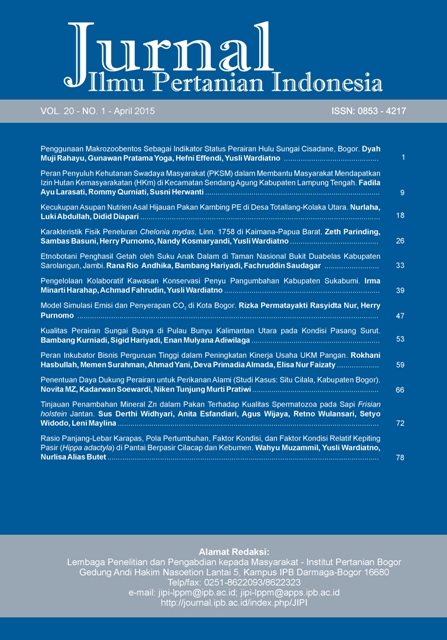Penentuan Daya Dukung Perairan untuk Perikanan Alami (Studi Kasus: Situ Cilala, Kabupaten Bogor)
Abstract
This study aimed to assess the aquatic carrying capacity for extensive fishing. The study was conducted in Cilala Lake, Jampang Village, Bogor. The carrying capacity was determined based on primary productivity using the chlorophyll value, which is indicating the existence of phosphate in waters. The result showed that carrying capacity of Cilala Lake for extensive fishing was 3.51 tons/year. Tilapia was the fish which could be restocked, because it has high tolerance to waters condition and there’s not prey or predator for this fish. If fish for restocking was assumed about 25 g in size and would be about 250 g after 46 months (harvest size), then the maximum stocked was 15.602 fingerlings/year for two periods. The number of fish pen cage available on the lake should be considered in calculating the number of fish for restocking.
Downloads
References
Amelia CD, Hasan Z, Mulyani Y. 2012. Distribusi spasial komunitas plankton sebagai bioindikator kualitas perairan di Situ Bagendit Kecamatan Banyuresmi, Kabupaten Garut, Provinsi Jawa Barat. Jurnal Perikanan dan Kelautan. 3(4): 301-311.
Andersen JH, Schlüter L, Ærtebjerg G. 2006. Coastal eutrophication: recent developments in definitions and implications for monitoring strategies. Journal of Plankton Research. 28(7): 621-628.
Anderson DM, Glibert PM, Burkholder JM. 2002. Harmful Algal Blooms and Eutrophication: Nutrient sources, Composition, and Consequences. Estuaries. 25(4b): 704-726.
Bell JD, Leber KM, Blankenship HL. 2008. A New Era for restocking, stock enhancement and sea ranching of coastal fisheries resources. Reviews in Fisheries Science. 16(1-3): 1-9.
Beveridge MCM. 1984. Cage and pen fish farming: carrying capacity models and environmental impact. FAO. Fisheries Technology Paper (255): 131 p.
Beveridge MCM. 2004. Cage Aquaculture. Third Edition. Blackwell Publishing, London (GB).
Carlson RE. 1977. A trophic state index for lakes. Limnological Research Center. University of Minnesota. Minneapolis. 22(2): 361-369.
Costa-Pierce BA, Byron CJ. 2010. Carrying capacity tools for use in the implementation of an ecosystem approach to aquaculture. In FAO Expert Workshop on Aquaculture Site Selection and Carrying Capacity Estimates for Inland and Coastal Waterbodies. Institute of Aquaculture. University of Stirling. Stirling (GB). 6-8 Desember 2010. 23 p.
De Silva SS, Amarasinghe US, Nguyen TTT. 2006. Better-practise approaches for culture based fisheries development in Asia. ACIAR Monograph No. 120. Australian Centre for International Agricultural Research. Canberra (AU).
Eaton AD, Clesceri LS, Rice EW, Greenberg AE. 2005. Standard methods for the examination of water and waste water. 21st ed. American Public Health Association (APHA), American Water Works Association (AWWA), Water Environment Federation. Washington DC (US).
Garno YS. 2002. Kualitas perairan Waduk Cirata: Dinamika kualitas air di dua lokasi yang berbeda jumlah keramba jaring apungnya. Jurnal Teknologi Lingkungan. 3(1): 50-60.
Guo L, Li Z, Xie P, Ni L. 2009. Assessment effects of cage culture on nitrogen and phosphorus dynamics in relation to fallowing in a shallow lake in China. Aquaculture International. 17(3): 229-241.
Kenchington RA, Hudson BET. 1984. Coral reef management handbook. Jakarta (ID). UNESCO Regional Officer of Science and Techbology in South East Asia.
Kurnia R. 2011. Model restocking kerapu macan (Epinephelus fuscoguttatus) dalam sistem sea ranching di perairan dangkal Semak Daun, Kepulauan Seribu. [Disertasi]. Bogor (ID): Institut Pertanian Bogor.
Legović T, Palerud R, Christensen G, White P, Regpala R. 2008. A model to estimate aquaculture carrying capacity in three areas of the Philippines. Science Diliman. 20(2): 31-40.
McKindsey CW, Thetmeyer H, Landry T, Silvert W. 2006. Review of recent carrying capacity models for bivalve culture and recommendations for research and management. Aquaculture. 261(2): 451-462.
Mims SD, Onders RJ. 2012. Chapter 8: Reservoir ranching. In Aquaculture Production System. First Edition. Edited by: James Tidwell. John Willey & Son, Inc (US).
Novita MZ. 2013. Penentuan daya dukung untuk kegiatan keramba ikan hias di Situ Cilala, Kabupaten Bogor, Jawa Barat. [Skripsi]. Bogor (ID): Institut Pertanian Bogor.
Paerl HW, Otten TG. 2013. Harmful cyanobacterial blooms: Causes, consequences, and controls. MIcrobial Ecology. 65(4): 995-1010.
Pratiwi NTM, Adiwilaga EM, Basmi J, Krisanti M, Hadijah O, Wulandari P. 2007. Keberadaan Situ Cilala ditinjau dari beberapa aspek limnologis. Journal of Fisheries Sciences. 9(1): 82-94.
Rahman A, Purnamaningtyas SE. 2011. Kualitas biologi perairan Situ Cileunca Kabupaten Bandung Jawa Barat berdasarkan bioindikator plankton. Jurnal Akuatika. 2(2): 136-144.
Santoso R. 2014. Kompleksitas komunitas perairan pada status kesuburan perairan di Situ Cilala, Bogor, Jawa Barat. [Skripsi]. Bogor (ID): Institut Pertanian Bogor.
Soegesty NB. 2013. Keterikatan kegiatan keramba jaring apung (KJA) dengan tingkat kesuburan di Waduk Cirata, Jawa Barat. [Skripsi]. Bogor (ID): Institut Pertanian Bogor.
Smith VH. 2007. Using primary productivity as an index of coastal eutrophication: the units of measurement matter. Journal of Plankton Research. 29(1): 1-6.
This journal is published under the terms of the Creative Commons Attribution-NonCommercial 4.0 International License. Authors who publish with this journal agree to the following terms: Authors retain copyright and grant the journal right of first publication with the work simultaneously licensed under a Creative Commons Attribution-NonCommercial 4.0 International License. Attribution — You must give appropriate credit, provide a link to the license, and indicate if changes were made. You may do so in any reasonable manner, but not in any way that suggests the licensor endorses you or your use. NonCommercial — You may not use the material for commercial purposes.



















